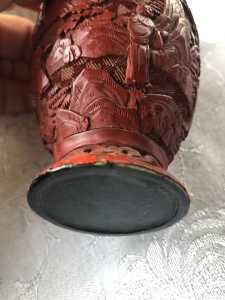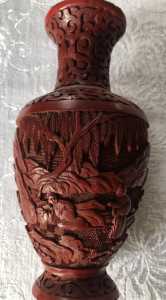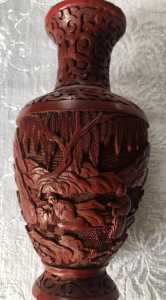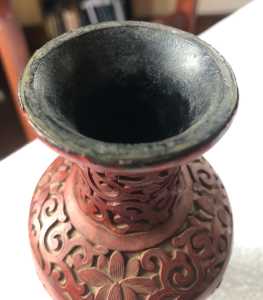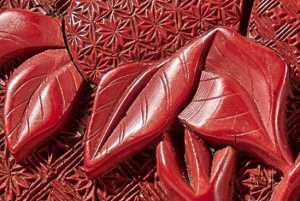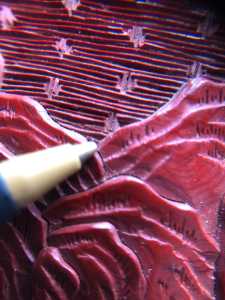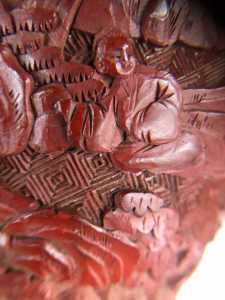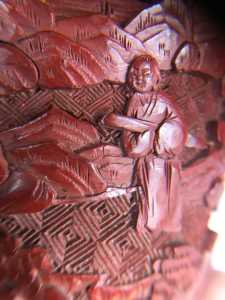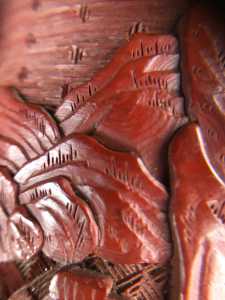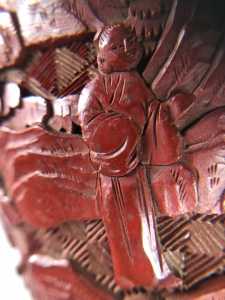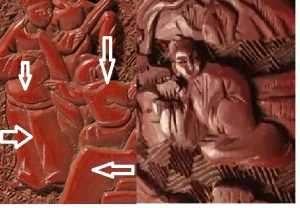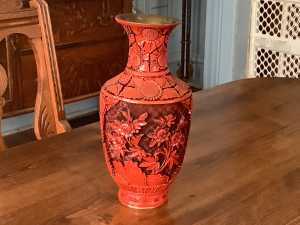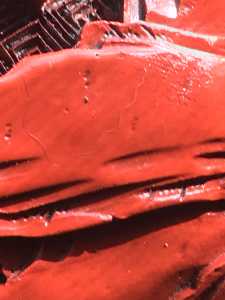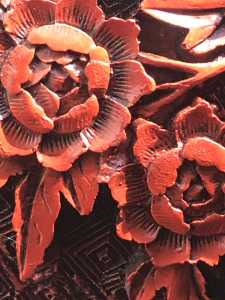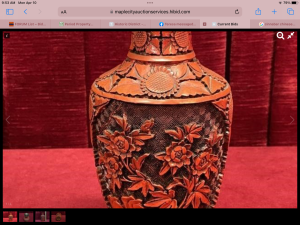The Chinese and Asian Art Forum. For Fans, Collectors and Dealers.
 Basic Rules For the BidAmount Asian Art Forum: Talk about whatever you want. You can even discuss and offer things that are for sale if they are authentic. Maximum image file size per post is 2 MB. Images of 700pxl x 700pxl are optimal if saved at a medium resolution. Be respectful of others and enjoy yourself. Click the YouTube link for a brief tutorial on using the forum. You can also EMBED Videos by cutting and pasting from You-Tube, Vimeo etc.
Basic Rules For the BidAmount Asian Art Forum: Talk about whatever you want. You can even discuss and offer things that are for sale if they are authentic. Maximum image file size per post is 2 MB. Images of 700pxl x 700pxl are optimal if saved at a medium resolution. Be respectful of others and enjoy yourself. Click the YouTube link for a brief tutorial on using the forum. You can also EMBED Videos by cutting and pasting from You-Tube, Vimeo etc.
NOTE: To post an item or add a new post, click open the category title from the FORUM LIST, and CLICK the Blue ADD TOPIC button.
I read through a post from last year about a lacquer box, but am still having a difficult time determining age. Any thoughts on this 15.5 cm people and landscape vase? Interesting with three background patterns of sky, upside down V and square earth pattern. I assume Qing until convinced of earlier. Is there any way to determine? Weight? Is 5.6 ounces.
@centralpapottery This vase is late 19th c. to early 20th c., so Qing. The way you can tell is actually not too hard once you have actually held/handled a genuine Ming cinnabar.
Start by keeping in mind that Mind cinnabar is about 100 times (mabye 1000 times) more rare than porcelain because it was very dangerous to make (do to having mercury in the lacquer), and required sometimes years to make a single piece (each layer of lacquer requires almost a week to cure, roughly 100 layers on Ming ware cinnabar piece, and the wood core had to be sufficiently kiln dried that it would not warp/crack (which even after 500 years, they often don't).
The carving on genuine Ming cinnabar is deep, the edges of the the depictions are highly detailed, and the surfaces are quite rounded (no sharp visible cuts). During the 18th c., the Qianlong emperor tried to recreate Ming style cinnabar, but not terribly succesfully. Sometimes these pieces are mistaken as Ming, but I think most lacquer specialists (and there are very few) are able to distinguish them from actually Ming.
Your photos are not close up, but I can see that while the design is okay for late 19th c., it has the telltale 'faceted' surface and straight cuts of late Qing work, so absolutely no chance of being Ming.
The close up surfaces of Ming cinnabar are really quite fantastic - they look like carvings of heavily grained wood, each of the layers of lacquer looking like a growth ring in a tree trunk.
I have only ever owned one Ming cinnabar box, a 4 tier round box that I attempted to sell with Lark Mason a few years back. It didn't sell, because the photos (despite being good) were not good enough to convice Cinnabar buyers to bid (starting bid was $20,000).
I took the box back, and a year later I sold it to a Chinese dealer who came to the Miami show. The dealer actually told me he had seen it online on Lark's website, but did not think to fly to NY to view it (and didn't bid), so he was very excited to have the chance to buy it from me directly.
@greeno107 here are a few closeups. I was thinking all genuine cinnabar had the ‘tree ring’ look. The top of the stone to which the pen is pointing has at least 20 layers. So the whole piece is probably more like 30 or so rather than 100. The layers can also be seen on the person seated.
1st indication to recognize genuine cinnabar from faux are "bubbles", and from your pictures provided I've seen none on yours. On cheap fakes, you can find bubbles and mold seams as well...All Chinese genuine carved cinnabar have layers, how many supposed to be of layers, personally don't know (if there is a number of layers at all). I do not come across very often to cinnabar in my life.
@centralpapottery Yes, all real cinnabar has layers.... the difference is the number/thickness of layers. As you point out, yours has about 20 layers. The same depth of carving on a genuine Ming piece would have more than double. Again...very hard to notice the difference until you've actually handled a Ming piece.
@greeno107 sorry if I mislead. There is 20 just on that hill. Definitely not saying this is Ming… just showing pictures. Guessing there are at least 30 layers though. In my short search, I haven’t found many Ming vases, mostly boxes or other items. I’ve handled maybe 5 Qing and as far as I know none from Ming.
@centralpapottery I did not take your statement as misleading or argumentative. I could not find a good photo for comparison, but I worked with what I had available. Take a look...
The surfaces of Ming cinnabar are more rounded, which exposes more layers, and the layers are closer together. Qing cinnabar is flatter, only showing layers where the carving distinguishes the form (person's robe, face, background, etc).
The white arrows point to areas within the major cuts of the carving, and show the rounded nature of the inner carving by light and dark rings of the layers of the cinnabar.
I hope this helps, and good luck finding a genuine Ming cinnabar! They are quite rare, and many large auction houses mistaken 18th c. pieces copying the Ming style as genuine Ming cinnabar.
@greeno107 yes, I see what you mean. I think I only have one spot on my whole vase like that which is noticeable. Your photo has a number on one small area. Thanks! Very helpful. Also, mine is only a couple mm deep.
I have a few pieces like this that I think are late Qing. No bubbles, coarse layers. I have noticed that you have to work really hard to get them to show any color when you do the acetone test; is that the case with the older Ming pieces? I have often thought that the ca 1900 ones are not really lacquer, but instead some sort of artificial composite.
I would assume & I would expect different color of Cinnabar if to talk about 17c or 18c and a little bit more quality & life within carved object. Of course there are exceptions. I mean in general what I would expect.
And now number of layers on earlier examples. thanks Tim for a valuable & informative lesson here!
Regards
Hello all, I am still about doing more reading than posting. I hope Greeno will not be upset by furthering the discussion on Cinnabar because I just bought my first piece.
I bought this at a very local on line auction, it looked good enough to take a punt in the hope it was real and not resin. Well it turns out it is real cinnabar, I am into it for about $18US so really could not go wrong. It past the nail polish remover test and the layering test
it is hand carved
my question for those in the know is the age? I have no expectations of it being Ming but hope for it to be late Qing or republic. The bace is unmarked with no enamelling.
Ron
This could be cast resin and it’s a modern reproduction.
This information is very helpful.
I am assuming they did make genuine cinnebar in the late Qing, it's just not as high a quality as in the Ming prototypes.
Thanks for visiting "The BidAmount Asian Art Forum | Chinese Art"
If you sell on eBay, or have a shop feel free to post images and descriptions and links.
Check back often for discussion about the latest news in the Chinese art and antique world. Also find out about the latest Asian art auctions at Sotheby's, Christie's, Bonhams and Tajans.
Auction results for: fine porcelain, ceramics, bronze, jade, textiles and scholar's objects. As well as Japanese, Thai, Vietnamese and other Asian cultures.
Thank you,
Peter Combs
Topics and categories on The BidAmount Asian Art Forum | Chinese Art
Kangxi vases, Kangxi dishes and chargers, Kangxi ritual pieces, Kangxi scholar's objects, Qianlong famille rose, Qianlong enamels, Qianlong period paintings, Qianlong Emporer's court, Fine porcelain of the Yongzheng period. Chinese imperial art, Ming porcelain including Jiajing, Wanli, Xuande, Chenghua as well as Ming jades and bronzes.
The BidAmount Asian Art Forum | Chinese Art
A free Asian art discussion board and Asian art message board for dealers and collectors of art and antiques from China, Japan, Korea, Thailand, Cambodia, Vietnam and the rest of Asia. Linked to all of the BidAmount Asian art reference areas, with videos from plcombs Asian Art and Bidamount on YouTube. Sign up also for the weekly BidAmount newsletter and catalogs of active eBay listing of Chinese porcelain, bronze, jades, robes, and paintings.
The art of calligraphy - and for the ancient Chinese it certainly was an art - aimed to demonstrate superior control and skill using brush and ink. Calligraphy established itself as one of the major Chinese art forms during the Han dynasty (206 BCE - 220 CE), and for two millennia after, all educated men were expected to be proficient at it.
The Museum’s collections of Asian art span nearly five millennia and encompass the cultures of China, the Himalayas, India, Japan, Korea, and Southeast Asia. In 2007, the Museum launched an initiative to create dedicated galleries for the collection, beginning with a gallery for the arts of Korea ...
Chinese art is full of symbolism, in that artists typically seek to depict some aspect of a totality of which they are intuitively aware.
China Online Museum is the finest online museum of Chinese art. It features Chinese calligraphy, painting, ceramics, bronzes, carving, and other artworks.
Chinese Ceramics & Works of Art. Overview Upcoming auctions Contacts Auction results ... Christie’s sales of Chinese ceramics and works of art showcase centuries of Chinese history. Held throughout the year in London, New York, Paris and Hong Kong, they attract a wide audience of collectors and connoisseurs vying for pieces as diverse as ...
Explore Asian Art Week. Contact the Specialist Department. Chinese Paintings ... Senior Specialist, Head of Sale. [email protected]. Tel:+1 212 641 5760. Bid in-person or online for the upcoming auction:Fine Chinese Paintings on 10 September 2019 at New York. Bid in-person or online for the upcoming auction:Fine Chinese Paintings on 10 ...
Discover an abundance of must-see art from all corners of a vast continent at Christie’s NY Asian Art Week. From contemporary classical and Chinese paintings to works with exemplary provenance from the Art Institute of Chicago, our Rockefeller Paza galleries will be full of ancient treasures and contemporary masterworks in a salute to the vibrant arts of Asia.
Sold to benefit The Art Institute of Chicago’s Asian Art Acquisition Fund, the sale features 84 lots with a focus on Ming and Qing porcelains, and offers a rare insight into the taste for collecting Chinese ceramics and works of art in the Midwest from the end of the 19th century through the 1980s. Highlights include two Wanli wucai garlic-head vases, a Qianlong mark and period, blue and ...
Specialist, Chinese Paintings, Christie's London Dr Malcolm McNeill is a Specialist in Chinese Paintings at Christie’s, based in London. He previously worked as an assistant curator of the Chinese collections and the Victoria and Albert Museum in London, as a researcher at the British Museum, and as a translator and tour guide at the National Palace Museum in Taipei.
The Christie's Education 2020 Conference: The Chinese Art Market 18 Jun 2019 Christie’s Education is delighted to announce our first international academic conference in Asia which will take place in Hong Kong from 26-27 November 2020 at the Hong Kong Convention and Exhibition Centre and will run in parallel with Christie’s Hong Kong Autumn Auctions.
The summer Chinese Art sale in Hong Kong will feature works of art from several private collections, including Qing porcelains and textile from the collection of the legendary Chinese art dealer A. W. Bahr (1877–1959), fine gilt bronze Buddhist sculptures from an old Hong Kong collection, an East Asian collection of Qing dynasty wine cups and jades, and a Japanese collection of Song ceramics ...
Sotheby's Chinese Works of Art Department holds two auctions each year in London, New York, Hong Kong and Paris.
Chinese Art - View Auction details, bid, buy and collect the various artworks at Sothebys Art Auction House.
With more than 340 Chinese works of art dating from the Neolithic to the Republic periods, highlights of this sale include a selection of Qing Imperial monochromes from the collection of Arnold and Blema Steinberg, early ceramics from the Art Institute of Chicago and Chinese porcelain and works of art from the collection of Henry Arnhold.
Results: Sotheby's Asia Week achieved $52.4 million in six strong auctions, exceeding pre-sale estimates. With 76.5% of lots sold and 60.3% of lots surpassing high estimates, the Asian art sales at Sotheby's indicate continued collector interest in the finest works of art from China, India and and the Himalayas.
Today's sale of Important Chinese Art will proceed as planned with sessions at 10 AM and 2 PM EDT. Sotheby's will be monitoring the weather conditions throughout the day and will be available to coordinate alternative bidding options should conditions make it difficult for clients to attend the auction in person.
Bonhams Chinese Art department is renowned for offering the finest works of art representing the richness and breadth of China's artistic heritage, particularly Imperial porcelain, white and spinach green jades, cloisonné and Buddhist art. Specialised international auctions are held globally, including London, Hong Kong and San Francisco.
Bonhams : Chinese Works of Art We use cookies to remember choices you make on functionality and personal features to enhance your experience to our site. By continuing to use our site you consent to the use of cookies. Please refer to our privacy and cookie policies for more information.
Bonhams Fine Art Auctioneers & Valuers: auctioneers of art, pictures, collectables and motor cars. We use cookies to remember choices you make on functionality and personal features to enhance your experience to our site. By continuing to use our site you consent to the use of cookies. ... Chinese Art (US) General enquiries
Bonhams : Fine Chinese Art We use cookies to remember choices you make on functionality and personal features to enhance your experience to our site. By continuing to use our site you consent to the use of cookies. Please refer to our privacy and cookie policies for more information.
Bonhams Fine Art Auctioneers & Valuers: auctioneers of art, pictures, collectables and motor cars Bonhams : Asian Art We use cookies to remember choices you make on functionality and personal features to enhance your experience to our site.
Bonhams are international auctioneers of fine Chinese and Japanese art. We specialise in rare Imperial and Export Chinese ceramics and works of art, as well as Japanese ceramics, fine and decorative works of art from the Neolithic Period to the 20th century. View on map
Bonhams Fine Art Auctioneers & Valuers: auctioneers of art, pictures, collectables and motor cars. We use cookies to remember choices you make on functionality and personal features to enhance your experience to our site. By continuing to use our site you consent to the use of cookies. ... Asian Art Bonhams. Work. 22 Queen St.
